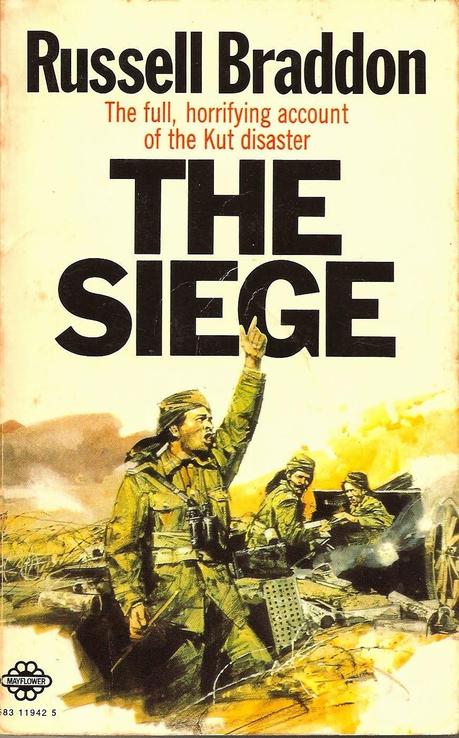 Braddon, Russell. The Siege: The Full, Horrifying Account of the Kut Disaster. New York: Viking Press, 1970. Originally published 1969. 352 pp.
Braddon, Russell. The Siege: The Full, Horrifying Account of the Kut Disaster. New York: Viking Press, 1970. Originally published 1969. 352 pp.Some wars are so ill-conceived and badly-waged that even when successful, they seem a colossal waste. The Crimean War fascinates me for this reason: whatever Russia and Turkey's territorial disputes, Britain and France's intervention is inexplicable, exacerbated by their commanders' military idiocy. The First World War, celebrating its centennial this year, is even worse. The airy rhetoric about freedom belies that it was an old-fashioned imperial struggle, no nobler than the Crimea. Of all the misbegotten slaughters generated by that conflict, Britain's invasion of Mesopotamia (modern Iraq) seems singularly pointless.
Russell Braddon's The Siege depicts the campaign's most infamous debacle: the siege and surrender of General Townshend's 6th Indian Division at Kut. This sorry tale of military and political incompetence, resulting in the death or capture of 43,000 Anglo-Indian troops by Nureddin Bey and Halil Bey's Turkish Sixth Army, proved Britain's greatest humiliation of the First World War. Braddon eschews dispassionate analysis, lamenting the British and Indian soldiers whose "fate was decided for them by idiots" (10). In spite (or because) of this, it's one of the best books ever written about military incompetence.
Britain's involvement in Mesopotamia mixed inertia and ambition. Given its interest in the Persian Gulf and Ottoman Turkey's hostilities, the initial movements weren't uncalled for. Indian troops captured the oil fields around Basra in fall 1914. This action resulted in few casualties and secured vital resources for the British military, enhanced by exploratory probes up the Tigris River. But these easy victories encouraged Indian officials to dream bigger: Viceroy Beauchamp even envisioned Mesopotamia as a potential colony.
By fall of 1915, General John Nixon was planning an offensive towards Baghdad. In retrospect, the campaign's strategic justification seems dubious: the Turks were too weak to counterattack, British resources already stretched thin. Yet Mesopotamia then seemed the only campaign with any potential. The Western Front was bloody stalemate; Winston Churchill's Gallipoli gambit degenerated into disaster; Russia was retreating, Serbia overrun and Italy bloodily repulsed. "Nowhere, in any of the Allied theaters of war, was there glimmer of hope: except, perhaps at Baghdad" (82).
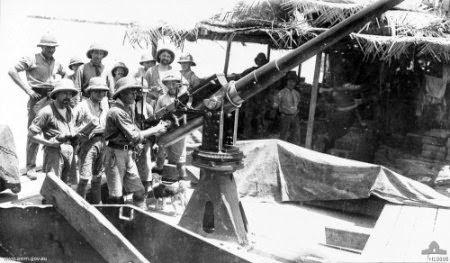
Gunners on a Tigris River barge.
Enter Major General Charles Townshend. Descended from Field Marshal George Townshend, Wolfe's second-in-command at Quebec, Townshend was a gallant soldier but a ceaseless climber. He served with distinction in the Sudan, taking part in both the Gordon Relief Expedition and later Kitchener's Omdurman Campaign. However, he was best-known for defending the Northwest Frontier post at Chitral in 1895 against a two-month siege. This small but dramatic victory won him a Victoria Cross and an audience with the Queen.The attendant fame fed Townshend's already healthy ego. He became aide to Redvers Buller, commander-in-chief in the Boer War, serving in various staff positions. At the outbreak of World War I, Townshend languished in Egypt. "Chitral Charlie" incessantly badgered superiors for high command, styling himself an expert on military strategy. "Restless, ruthless, highly professional and loyal only to his own relentlessly driving ambitions" in Braddon's words (30), Townshend finally won appointment to the 6th Indian Division.
Townshend revealed his true character after Nixon proposed an initial, limited advance on Ctesiphon. Privately Townshend expressed doubts, even writing General Archibald Murray of the Imperial General Staff a letter attacking Nixon's unclear goals and insufficient manpower. "All of these ofensive operations in secondary theaters are dreadful errors in strategy," he wrote, "In violation of all the great fundamental principles of war." Braddon notes that "his military judgment... would prove to have been flawless" (61).
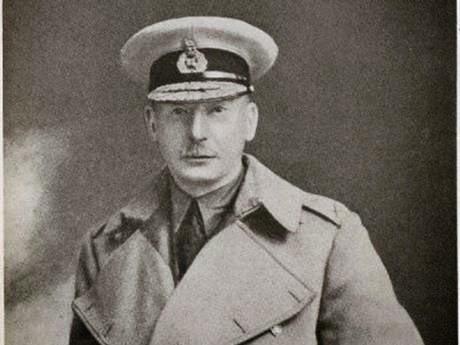
Charles Townshend.
When Nixon consulted Townshend, the latter raised none of these objections. Indeed, he even suggested "he would almost certainly pursue the enemy" to Baghdad (65). In fairness, the initial idea wasn't Townshend's, and in essence he only followed orders. Yet there's no question that his ambition fanned Nixon's imagination. He privately mused: "Who knows that I shall not eventually become Governor of Mesopotamia?" (27) So in September 1915 Townshend's 6th Division began their advance, 13,000 strong against Turkish forces three times as large.The campaign started well. Using a makeshift fleet of barges and river steamers dubbed "Townshend's regatta" (44), the General navigated the treacherous Tigress and Mesopotamian swamplands. He bested the Turks in several battles, though often more by luck more than skill: at Es Sinn, a brigade became lost deploying and accidentally ended up in the Turkish rear! Finally at Ctesiphon Townshend's luck ran out, suffering heavy casualties in a Pyrrhic victory. By late December Townshend fell back on the fly-blown, filthy village of Kut el Amara, where Nureddin soon encircled him.
The 147 day siege (the longest in British history) proved a horrific ordeal for 6th Division. Drawing on firsthand accounts from surviving soldiers, Braddon recounts their plight in graphic detail. Plagued by dysentery and typhus, besieged by lice and sand flies, harassed by hostile locals, Turkish shellfire proved their least nagging worry. After several months the men resorted to meals of horse heads, dogs and dry grass. Medical supplies proved inadequate, the men suffering as "their bowels and stomachs disintegrat[ed] into green slime... chang[ing] from lean men into leathery skeletons" (260). It makes for painful reading.
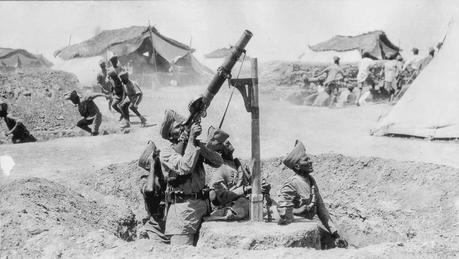
Indian troops in action at Kut.
These long-suffering soldiers were ill-served by their commander. Townshend, so energetic and decisive a few months prior, froze under duress. His communications with Nixon brimmed with panicked miscalculations of supplies (saying, for instance, he had a month's worth of food when he really had four) and veiled accusations of indifference. Indeed, hastily-organized relief force - ironically led by General Fenton Aylmer, Townshend's savior at Chitral - suffered 20,000 casualties trying to rescue Townshend. In extremis, the British even tried bribing Halil Pasha for the garrison's relief. A young intelligence captain, T.E. Lawrence, took part in this affair.While Aylmer's troops fought to relieve him, Townshend made no efforts to break out or materially aid his benefactor. Incredibly, Townshend forbid even sorties, reasoning that "sorties out... inevitably involve a withdrawn in: and too many withdraws sap morale" (142). His only leadership came through increasingly pompous and delusional communiques, which confused as often as they inspired. Nixon replaced Aylmer with General George Gorringe, and the slaughter continued.
Finally, on April 29th, 1915 Townshend surrendered. Despite his declaration to "go into captivity with my troops" (335) the General enjoyed comfortable confinement, hobnobbing with Turkish officials and even becoming an ad hoc diplomat at war's end. His soldiers weren't so lucky, enduring a forced march through Mesopotamia, then worse. Some labored on the Baghdad-Berlin Railway; others languished in prison camps, where they endured to floggings, rapes, summary murder and general ill-treatment. Meanwhile, the Indian government censored all mention of Kut, even as exchanged prisoners began trickling home and Parliament investigated misconduct.
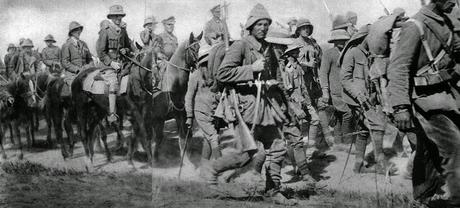
British troops on their way to captivity.
Braddon recounts this disaster in angry, venomous prose. A former POW himself (recounted in The Naked Island), Braddon makes no effort to hide his contempt for Townshend and his superiors, nor his sympathy for the rankers suffering at their hands. He describes with contemptuous relish how British officers dined on plum cake and champagne while their soldiers ate moldy biscuits and brackish water, or Townshend and staff shipping sporting equipment alongside military supplies. "No one questioned, then, the validity of the social hierarchy" (86) which placed officer comforts above soldier necessities.It's true, as recent historians like N.S. Nash (Chitral Charlie) and Charles Townshend (Desert Hell: The British Invasion of Mesopotamia) argue, that General Townshend merely executed India's ill-advised policies and Nixon's boneheaded strategy. His tactical ability and physical courage on the road to Kut are commendable. His changing clothes during battle, presumably included by Braddon to demonstrate Townshend's foolishness, could be interpreted as coolness under fire. It's certainly unfair to blame Townshend for his treatment in captivity. And it's notable that the soldiers Braddon interviewed almost to a man "believe[d] [Townshend] to be a brilliant leader and a splendid man" (9).
But Townshend made the decision to stand at Kut, a town of marginal importance and limited defensibility. He was responsible for his hysterical telegrams that panicked Nixon and Aylmer into ill-advised rescue attempts. He remained inert while Aylmer's men died trying to relieve him. Finally, anyone declaring himself a genius equal to Belisarius, Bonaparte and Clausewitz en route to catastrophe invites derision. Anyone more concerned with accession to a peerage than his men deserves limited sympathy. And any General asking his starving soldiers to "give a little sympathy to me" (209) is indefensible.
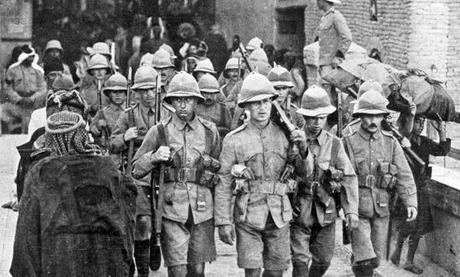
British troops entering Baghdad, March 1917
Under new management, British troops finally captured Baghdad in March 1917. General Stanley Maude achieved this with 50,000 troops, nearly quadruple Townshend's numbers. Yet the war didn't end: Halil's Turks fought a bloody rearguard action until November 1918, a month after Turkey's surrender. Britain's new colony exploded into full-blown rebellion in 1920, foreign conquest driving the country's sectarian difficulties to the fore. Needless to say, we're still dealing with the fall-out of this ill-judged campaign.
